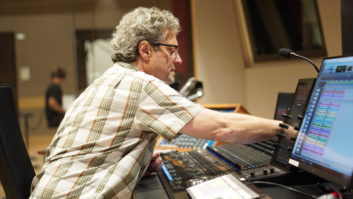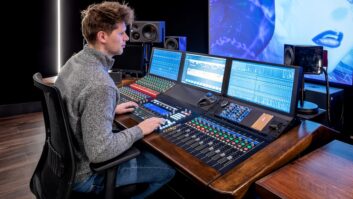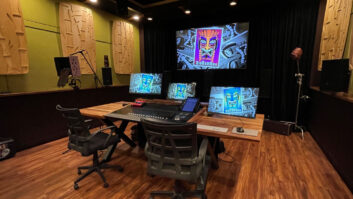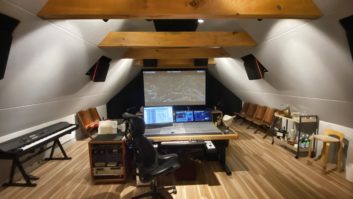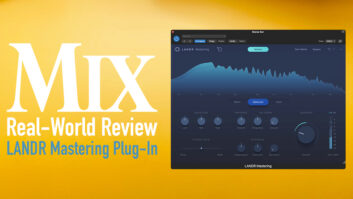As today’s audio engineers increasingly work on projects remotely— serving clients from nearly anywhere around the world— project sharing and distribution tools have become more important than FedEx, UPS and the studio “runner” of days gone by. Our modern digital tools for collaboration have made what was once impossible possible.
Nashville-based Russ Long—a prolific music producer/engineer—largely depends on Dropbox for sharing content with clients. “When I’m collaborating on a project, nothing works as well as Dropbox,” Long insists. “Everyone sharing a folder can add files, make updates and so on.”
There are issues in relying on Dropbox, says Long. “If someone is careless, they can easily delete my work—it can potentially be a disaster. If I’m working on a project in a shared Dropbox folder, I always copy the contents out of Dropbox so I have an archive outside of the shared folder. Then, when I’m finished with my work, I’ll copy the updated data back into the shared folder. I typically print my mixes to a Dropbox folder. This makes it easy to check them through my phone on my way home from the studio and reference in my project studio or my home theater.”
A more secure alternative to Dropbox, offers Long, is Gobbler, designed specifically for music production needs.
“I use Gobbler for cloud backup and to deliver mixes to my clients,” he explains. “I love Gobbler’s interface; best of all, it informs me of downloads. If I send a mix to an artist, the producer and label A&R, I get an email when each of them has the mix, telling me specifically who downloaded it and when.” If a client doesn’t download a delivery, Gobbler will automatically send them a reminder the following day.
Grammy-nominated composer/sound designer and producer/engineer Rich Tozzoli insists that his FiOS service—a bundled media service from Verizon via fiber-optic network—is key to his project sharing workflow. “Much of my work is done with clients in LA, New York or Europe,” he explains. “Downloads come to me via YouSendIt or Dropbox. Those are the bigger files—full Pro Tools sessions with all the audio. For me, FiOS is very fast. Uploads and downloads average 50-plus Mbps; with small files under 10 MB, I will just email them the mixes as an attachment to keep things simple. Anything bigger is output by on Drop-Box, YouSendIt, or via FTP.”
When uploading, Tozzoli usually drops files directly onto his clients’ servers. “FTP is easy, fast and a good way to go back and forth,” he explains. “I don’t often have to work on sessions with other people. Being mostly self-contained, it’s simply a process of outputting the files, and immediately uploading them to clients via the method of their choice. It’s amazing to write a TV track and have it in LA within minutes of mixing it.”
Rob Tavaglione, owner/proprietor of Catalyst Recording in Charlotte, NC, largely serves a local and regional client base with an increasing number of national and international clients. Of our review contributors, that makes his project-sharing tendencies the most widely ranging in method and scope.
“I find that jobs for out-of-state and even international clients are increasing, with about ten times more ‘virtual clients’ than even just a few years ago,” Tavaglione explains. “While I still find co-composing and musical collaboration to be much more fluid and rewarding when sharing the same room, when mixing and mastering, I find myself enjoying the advantages of distance; the impersonal nature of the process—essentially the lack of human distractions—allows me to focus on the work’s specific issues.”
Dropbox is generally the choice of Tavaglione’s clients, “whether sending individual tracks for mixes, stems for mixes or mixes for mastering,” he offers. “Google Play seems to be getting more popular—quickly, too. But when it comes to me submitting files to clients for proofs, I pretty much always use MP3s for approval, simply attaching them to e-mails via Google Gmail. This seems to work well for recipients on desktops, laptops, tablets and phones—largely preventing panicky late-night ‘I can’t download today’s rough’ texts. For larger files, like WAV masters, I always use WeTransfer for its inherent simplicity: no passwords, no permissions, and no hassles. Also, CD masters are WeTransfer’ed as DDPs (Disc Description Protocol).”
Often working with DIY indie acts, Tavaglione has found SoundCloud to be a valuable asset for pre-production. “It works really well for bands with lots of material to share,” he explains, such as song ideas, rehearsal recordings, roughs and works in progress.
“There’s nothing at all I miss about the days of walking out of the studio by 9:10pm with a DAT in hand to make sure I make FedEx’s last pickup at 9:30pm,” recalls Long. “Regardless of whether I’m working with someone across town or on the other side of the world, we now have access to each other’s media—anytime and anywhere.”
Next month in this space, we’ll look forward to emerging project sharing and collaboration tools such as Avid Everywhere, among others.
